Most of us are aware that the Pacific Ocean lies between the Americas in the east, and Oceania and Asia in the west. The Atlantic Ocean sits between Europe and Africa in the east, and the Americas in the west.
The Pacific Ocean is the world’s largest and deepest ocean, covering approximately 165 million square kilometres. It has an average depth of 4,280m. The Atlantic Ocean comes in second, with an area of around 107 million square kilometres and an average depth of 3,646m.
Do the Pacific and Atlantic Oceans mix?
The Pacific and Atlantic Oceans do mix and are not separate. While we’ve given our planet’s oceans separate names, in reality there’s no border between them, and currents continually flow between them and mix their waters.
Still, each of the planet’s oceans and seas has its own characteristics. For example, the surface salinity of the Atlantic is higher than the Pacific and Indian Oceans, while the enclosed waters of the Red Sea and the Mediterranean are saltier still.
This is because lower salinity waters from the deep sea cannot easily flow in, and water evaporates faster than rainfall can replace it.
Where do the Pacific ocean and Atlantic ocean meet?
The Atlantic and Pacific meet at Cape Horn, at the southernmost tip of Chile, South America. In this region, a strong current carries water from west to east, sweeping water from the Pacific into the Atlantic.

Travelling around Cape Horn is a turbulent, dangerous journey to make by ship and has claimed many lives. Prior to the building of the Panama Canal, it was the sole route by sea between the Pacific and Atlantic.
The viral videos you may have seen online showing two different coloured bodies of water drifting alongside each other, claiming to be the meeting point of the Atlantic and Pacific, are actually showing light-coloured, sediment-rich freshwater from melted glaciers meeting dark, salty ocean water in the Gulf of Alaska (and over time, currents and eddies cause these to mix, too).
This original video was shot in 2015, but was later mislabelled as being the meeting point of the Pacific and Atlantic.
This article was first published 19 November 2020. It was reviewed by Thomas Ling 12 July 2023.
Read more about the oceans: